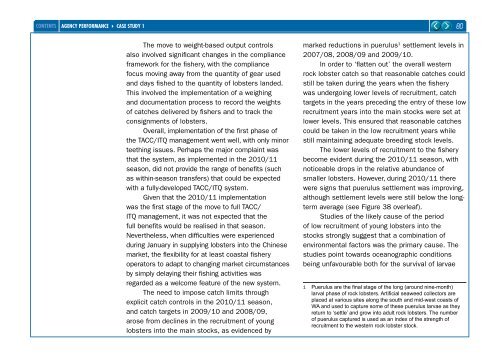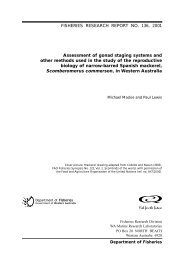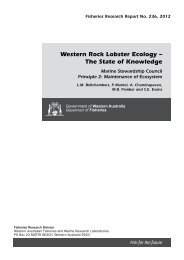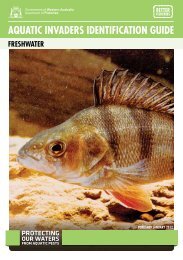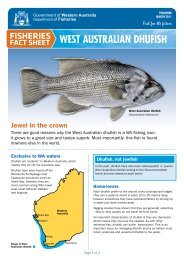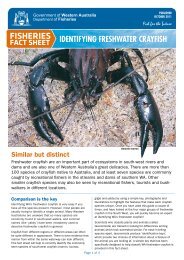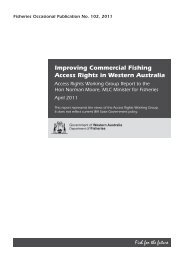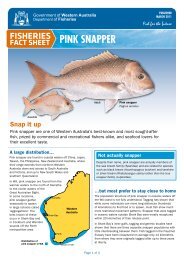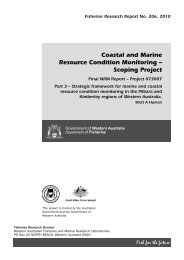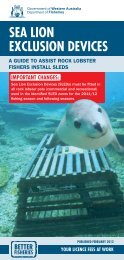DEPARTMENT OF FISHERIES ANNUAL REPORT TO THE ...
DEPARTMENT OF FISHERIES ANNUAL REPORT TO THE ...
DEPARTMENT OF FISHERIES ANNUAL REPORT TO THE ...
You also want an ePaper? Increase the reach of your titles
YUMPU automatically turns print PDFs into web optimized ePapers that Google loves.
AgENCy PERFORMANCE � CASE STUDy 1<br />
The move to weight-based output controls<br />
also involved significant changes in the compliance<br />
framework for the fishery, with the compliance<br />
focus moving away from the quantity of gear used<br />
and days fished to the quantity of lobsters landed.<br />
This involved the implementation of a weighing<br />
and documentation process to record the weights<br />
of catches delivered by fishers and to track the<br />
consignments of lobsters.<br />
Overall, implementation of the first phase of<br />
the TACC/ITQ management went well, with only minor<br />
teething issues. Perhaps the major complaint was<br />
that the system, as implemented in the 2010/11<br />
season, did not provide the range of benefits (such<br />
as within-season transfers) that could be expected<br />
with a fully-developed TACC/ITQ system.<br />
Given that the 2010/11 implementation<br />
was the first stage of the move to full TACC/<br />
ITQ management, it was not expected that the<br />
full benefits would be realised in that season.<br />
Nevertheless, when difficulties were experienced<br />
during January in supplying lobsters into the Chinese<br />
market, the flexibility for at least coastal fishery<br />
operators to adapt to changing market circumstances<br />
by simply delaying their fishing activities was<br />
regarded as a welcome feature of the new system.<br />
The need to impose catch limits through<br />
explicit catch controls in the 2010/11 season,<br />
and catch targets in 2009/10 and 2008/09,<br />
arose from declines in the recruitment of young<br />
lobsters into the main stocks, as evidenced by<br />
80<br />
marked reductions in puerulus 1 settlement levels in<br />
2007/08, 2008/09 and 2009/10.<br />
In order to ‘flatten out’ the overall western<br />
rock lobster catch so that reasonable catches could<br />
still be taken during the years when the fishery<br />
was undergoing lower levels of recruitment, catch<br />
targets in the years preceding the entry of these low<br />
recruitment years into the main stocks were set at<br />
lower levels. This ensured that reasonable catches<br />
could be taken in the low recruitment years while<br />
still maintaining adequate breeding stock levels.<br />
The lower levels of recruitment to the fishery<br />
become evident during the 2010/11 season, with<br />
noticeable drops in the relative abundance of<br />
smaller lobsters. However, during 2010/11 there<br />
were signs that puerulus settlement was improving,<br />
although settlement levels were still below the longterm<br />
average (see Figure 38 overleaf).<br />
Studies of the likely cause of the period<br />
of low recruitment of young lobsters into the<br />
stocks strongly suggest that a combination of<br />
environmental factors was the primary cause. The<br />
studies point towards oceanographic conditions<br />
being unfavourable both for the survival of larvae<br />
1 Puerulus are the final stage of the long (around nine-month)<br />
larval phase of rock lobsters. Artificial seaweed collectors are<br />
placed at various sites along the south and mid-west coasts of<br />
WA and used to capture some of these puerulus larvae as they<br />
return to ‘settle’ and grow into adult rock lobsters. The number<br />
of puerulus captured is used as an index of the strength of<br />
recruitment to the western rock lobster stock.


